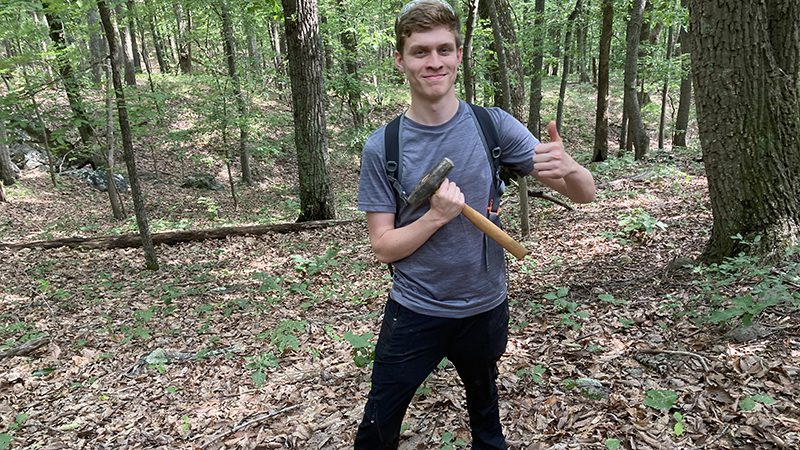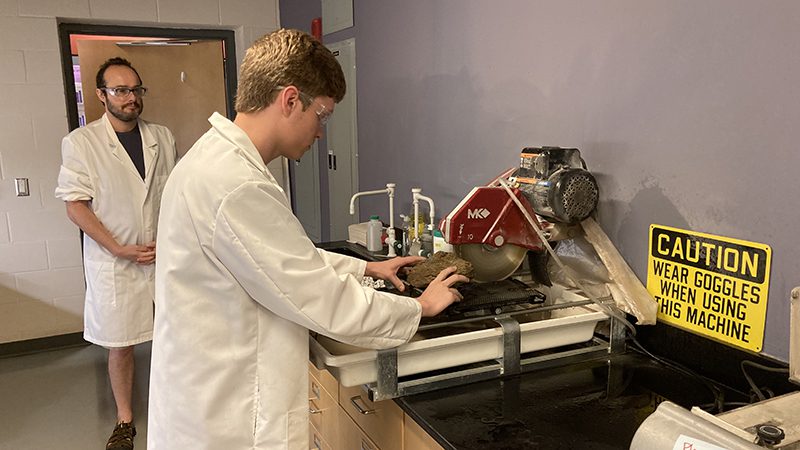Senior investigates how the Appalachians formed

Connor Gregory ’24 got a close look at kyanite last summer at a Virginia mountain where the mineral is mined. He got an even closer look in a Furman lab as he prepared samples for microscopic and chemical analysis.
You may not have been in the proximity he has, but kyanite is as close as your car’s spark plugs and brake shoes. The mineral’s properties include high thermal stability and low electrical conductivity. The practical applications are just part of what Gregory has come to love about his study of earth and environmental science: “Nothing’s ever going to be irrelevant,” he said.
Gregory’s thesis project is being supervised by Emma Hunt, assistant professor of earth sciences. From field work in 100 degrees to lab work in 12-hour stretches, he’s gotten a realistic taste of research.
“It’s not easy,” Hunt said. “There’s a lot of really hard work and late nights.”
Gregory is a double major – he’s studying music, too. It’s a lot to balance, but both fields are passions for him.
“It doesn’t necessarily feel like work, because it’s something I want to be doing anyway,” Gregory said.

The Summer 2023 field team (back, left to right) Gregory, Kerry Black ’24, Ethan Watson ’23; (front, left to right) Péter Horváth, adjunct professor of earth sciences, and Emma Hunt, assistant professor of earth sciences.
He met Hunt his junior year when he took a required minerology and petrology class. Through the class he discovered his interest in rocks and minerals, which hold secrets about the earth’s history and the formation and movement of its tectonic plates.
“It’s this really big picture understanding of how the earth has changed over time,” he said.
This past summer, Gregory spent 10 weeks on the kyanite research. Much of it was spent reading scholarly articles on the geology of the Appalachians. It wasn’t the lightest reading he’s ever done.
“The more syllables you have, the better, I guess,” he said, laughing. But he learned to digest dozens of pages and summarize key findings.
Hunt said that’s a key element of the senior thesis process. Students working through significant amounts of research have to learn where to skim and where to slow down, “how to distinguish what’s really useful for their aims,” she said. Research is one way students can gain high-impact engaged learning experiences, a central element of Furman’s educational framework, The Furman Advantage, which also includes mentoring, reflection, career preparation, and the Pathways Program advising curriculum.
For three days, though, Gregory got to be on site at Willis Mountain, near the center of Virginia.
“I liked actually seeing these rocks that I had been reading about,” he said.
Hunt said that’s the best part of geology – she’s done field work in North America, Europe, South Africa, Greenland, Iceland and Asia.

Gregory uses a rock saw to prepare samples for the creation of thin sections, while Horváth supervises.
Furman’s connection with the Kyanite Mining Corporation began in summer 2022 when Ethan Watson ’23 conducted research there. Watson collected samples and began a broad investigation of the temperatures and pressures at which kyanite would have formed in the metamorphic rocks that make up the Appalachians.
Gregory is continuing that work – called geothermobarometry – with Watson’s samples and more of his own. In the lab at Furman, he cleaned, photographed and cut the samples for microscope slides. (Those slides will be the foundation for another student’s summer research in 2024.)
Kyanite is not especially rare, but it is rare for it to be found in such a high concentration as it is in Willis Mountain. Its presence tells stories about “the metamorphic processes through the formation of the Appalachians,” Gregory said.
His summer also included a trip to Rice University in Houston to use its Electron Probe Microanalysis Lab to analyze the chemical compositions of his samples. By understanding the unique elements in a deposit and the concentrations of those minerals, researchers can model the temperatures at which those rocks were altered.
Next spring, Gregory will present the results of his work in Asheville at the Southeast Sectional Meeting of the Geological Society of America. He also is applying for graduate programs in geology. He’ll be ready for both.
“I’ve seen Connor develop his confidence in his abilities as a researcher, as an independent scientist,” Hunt said.